Empowering Students with Design Thinking & Coding Skills
The future belongs to the creators of smart solutions. This makes coding and design, essential skills to thrive in the modern, globalised world.
Teaching design thinking process and coding as an integral part of the curriculum fosters a mindset for innovation from an early age. It enables students to use design thinking and coding to solve problems and design sustainable solutions.
Let’s understand the process of Design Thinking
Design Thinking is a human-centric process for creative problem-solving.
Here’s how students work on a design thinking project where they are asked to design an app that solves a given problem:
Stage 1: Empathize
Students research and gather data to gain a deeper personal understanding of the problem and the needs of the users for whom they have to design the app.
Stage 2: Define
Based on their research and understanding, students identify and define the needs of the users and the core problems that need to be solved.
Stage 3: Ideate
Keeping in mind the needs of the users – students draw rough drafts of the app and brainstorm on the design of the User Interface (UI) that will keep the user at ease while interacting with the app.
Stage 4: Prototype
Students draw prototypes of the app and brainstorm which design will provide the best User Experience (UX). Once the app design process is completed, they will implement the functionality of the app as per user requirements.
Stage 5: Test
Students show their prototype to the users and ask them to use it & give their feedback. Through the feedback, students assess which features are expected, understand the drawbacks, and redesign the app to improve it further.
Design & Coding courses are better than just Coding courses
Design & coding courses help students in defining a problem and creating multiple iterations of solutions to test out. Starting to think about apps from a design standpoint encourages students to learn more about coding to develop an app.
These courses help them to learn the value of empathizing with others, identifying a need, and designing a solution through continuing feedback and iteration.
With coding courses, students only code an app/website (backend work) but with design & coding courses – in addition to coding, they also design an app/website while developing empathy. So, design & coding courses give students –the chance to show their skills to others by sharing their designed app/website.
Advantages of Design & Coding education
- Fosters 21st century skills like problem-solving, decision making, and creative thinking
- Working through problems increases self-confidence which enables students to adapt to new challenges
- Develops an awareness of the needs of people around them
- Motivates students to identify and develop innovative solutions to problems
- Develops design & coding skills and prepares students for jobs of the future
Careers in Design & Coding
- App Designer/Developer
- Web Designer/Developer
- User Experience (UX) Designer
- User Interface (UI) Designer
- Game Designer
- Computer Programmer
- Multimedia Artist & Animator
- Graphic Designer
- Film & Video Editor
ICT 360 in alignment with NEP, provides ICT curriculum with ready-to-use content, design and computational thinking approach to projects as well as interdisciplinary learning material on an online platform that caters to today’s relevant technologies and future skills requirements. It is designed to help teachers improve their instructional practices with 21st century teaching skills through train-the-teacher program, build a strong foundation to empower students with the ability and skills to design & create amazing things on their own in a fun & engaging environment, excel in academics and prepare them to be industry- and career-ready.
With 50+ partner schools across India, it aims to empower students with creativity, problem-solving, design and tech skills from an early age. By offering design and coding curriculum for schools (grades 1-10) – for AI, AR, VR, Coding, Media Design, App Design, Game Design, Web Design, 3D Printing, Robotics, IoT and Cloud Computing, ICT 360 prepares students for future job roles like Graphic Designers, AI & ML Specialists, Software & Applications Developers, Animators, Robotics Engineers, Data Analysts, and IOT Specialists.

